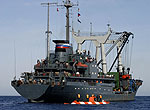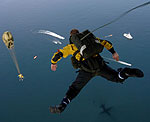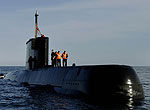Russia takes part in NATO submarine rescue exercise

A Russian rescue vessel, the RFS Titov, carrying a Deep Submergence Rescue Vehicle (DSRV), participated in a NATO submarine search-and-rescue exercise in the North Sea from 26 May to 6 June.

A Russian rescue vessel, the RFS Titov, carrying a Deep Submergence Rescue Vehicle (DSRV), participated in a NATO submarine search-and-rescue exercise in the North Sea from 26 May to 6 June.
Exercise Bold Monarch 2008, which took place off the coast of Kristiansand, Norway, was the largest-ever exercise of its kind. Fourteen countries – Canada, France, Greece, Germany, Israel, Italy, the Netherlands, Norway, Poland, Russia, Turkey, Ukraine, the United Kingdom and the United States – deployed personnel and rescue assets.
Additionally, personnel from other submarine operating navies around the world observed the exercise in order to help prepare and coordinate potential submarine rescue operations for their submarine forces. The list of international participants invited to observe the exercise included Argentina, Australia, China, India, Pakistan, Singapore, South Africa, South Korea and Spain.
The scenario involved the simulated sinking of a large submarine, the fictional HMS Serendipity, as a result of a collision with a merchant vessel. The submarine was resting at a depth of around 100 meters with up to 80 survivors. All submarine escape and rescue assets were employed on scene in a coordinated rescue and medical scenario.
The Russian DRSV conducted several meetings with Dutch and Norwegian submarines. People were successfully transferred from the submarines to the DSRV and up to the RFS Titov.

The Submarine Parachute Assistance Group exercised their role of being first response in the course of a rescue. Other assets employed included remotely operated vehicles; atmospheric diving suits; air supply/ventilation systems and divers; debris removal and emergency life support store re-supply. Submarine rescue vehicle pilots “mated” with the bottomed submarine to dry-transfer the submarine’s crew to safety.
The aim of the exercise was to train and demonstrate that NATO, in participation with other submarine operating nations, can perform life-saving operations in support of a distressed submarine, including all medical aspects involved in a submarine disaster.
The exercise also helped to validate assets and standard operating procedures, further develop rescue systems, and advertise submarine escape and rescue capabilities to nations outside NATO.

The International Submarine Escape and Rescue Liaison Office (ISMERLO), based in Norfolk, Virginia, the United States, was an integral part of the exercise, demonstrating its ability to coordinate rescue efforts.
ISMERLO operates under the authority of the NATO-led Submarine Escape and Rescue Working Group, of which Russia is a member. It was established to help ensure that one of the world’s several rescue systems is available to be deployed at moment’s notice. This is essential, given that there is usually only a 72-hour window within which to rescue crews on distressed submarines.
The need for such an international coordinating office was highlighted by the tragic loss of the crew of the Russian submarine, the Kursk, in August 2000.
NATO-Russia cooperation in the area of submarine-crew search and rescue at sea intensified following the signing of a framework agreement on cooperation in this area in February 2003 – and has contributed to a real-life rescue.
In June 2005, Russia took part in NATO’s submarine search-and-rescue exercise, Sorbet Royal. The experience and networks developed during the exercise contributed to the success of an actual rescue operation in August 2005 off the coast of the Russian Kamchatka peninsula.
Thanks to the database run by ISMERLO, the UK team that deployed to assist the rescue efforts had full access to the specifications of the stricken Russian submersible manned vehicle, and therefore knew what equipment would be needed.